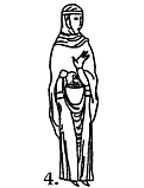 |
Later Anglo-Saxon Dress |  |
 |
Later Anglo-Saxon Dress |  |
 |
 |
 |
 |
 |
 |
 |
 |
 |
 |
 |
 |
 |
 |
 |
 |
 Cross garters can be a pain. They tend to fall down about the ankles if you aren't used to wearing them. They should be cut on the bias, or be from stretchy material. This helps. Also, the garters and hosa should not be made from a slick material. If all else fails, put on the garters over your hosa and mark where they cross. Remove them and the hosa and sew loops of material to match the garters at the crossings (fig. 16). When you put on the garters, thread the. construction. through the loops, which will help hold them in place. You will also need a couple of loops where the garters wrap around the legs at the knee. The ends of the garters were decorated with tags rather like belt ends, and sometimes had buckle for fastening. If you are and cut a making the cross-garters that cover the entire lower leg, either dye Ace bandages (nice and stretchy), or cut your garters on the bias.
Children seem to wear the same types of clothing as adults. Infant are shown wearing long gowns and either bare-headed or with a hood such as those worn by women.
Source:
Cross garters can be a pain. They tend to fall down about the ankles if you aren't used to wearing them. They should be cut on the bias, or be from stretchy material. This helps. Also, the garters and hosa should not be made from a slick material. If all else fails, put on the garters over your hosa and mark where they cross. Remove them and the hosa and sew loops of material to match the garters at the crossings (fig. 16). When you put on the garters, thread the. construction. through the loops, which will help hold them in place. You will also need a couple of loops where the garters wrap around the legs at the knee. The ends of the garters were decorated with tags rather like belt ends, and sometimes had buckle for fastening. If you are and cut a making the cross-garters that cover the entire lower leg, either dye Ace bandages (nice and stretchy), or cut your garters on the bias.
Children seem to wear the same types of clothing as adults. Infant are shown wearing long gowns and either bare-headed or with a hood such as those worn by women.
Source: